Guam: Operations of the 77th Division, 21 July - 10 August 1944 (ENG)
Подождите немного. Документ загружается.

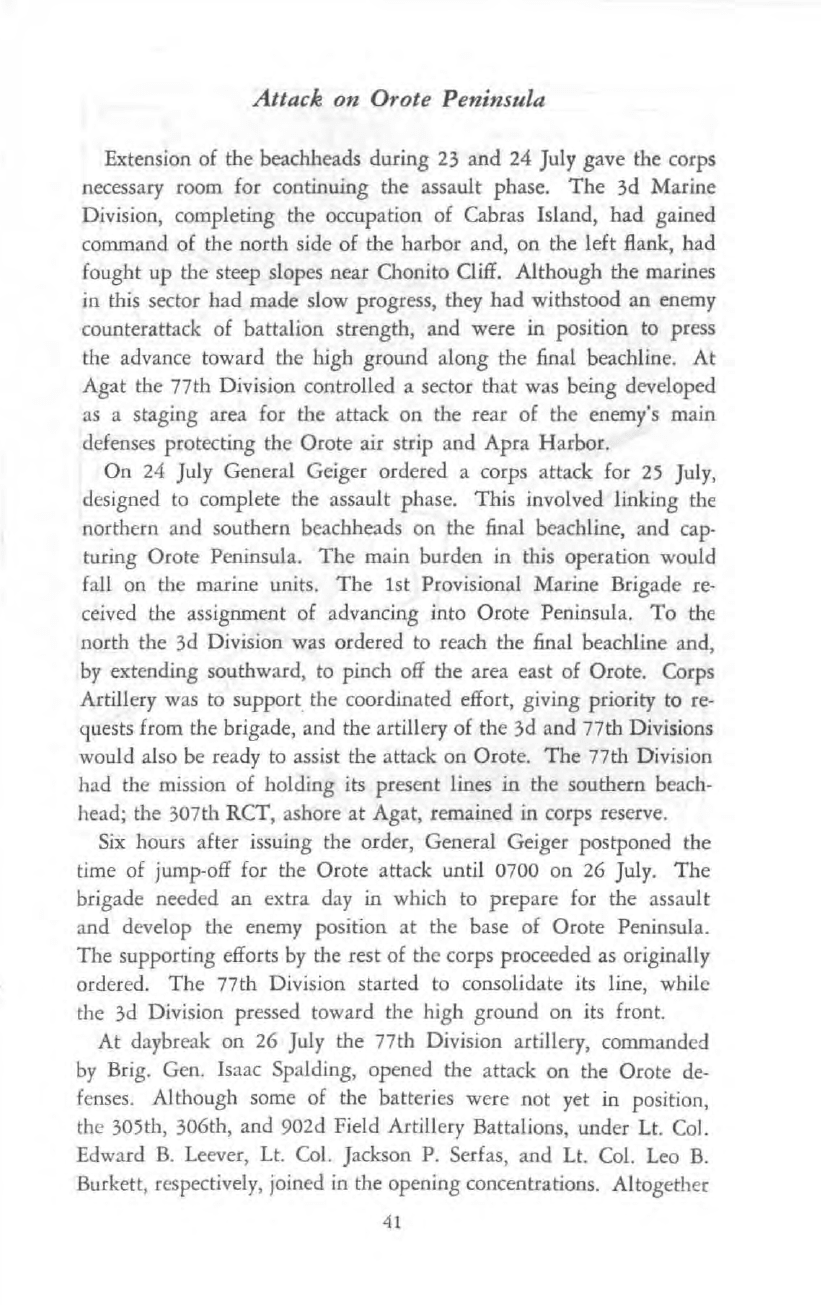
Attack
on Orote Peninsula
Extension of the beachheads during
23
and
24
July gave the corps
necessary room for
continuing the assault phase. The 3d Marine
Division, completing the occupation of Cabras Island, had gained
command of the north side of the harbor and, on the left flank, had
fought up the steep slopes near Chonito Giff. Although the marines
in this sector had made slow progress, they had withstood an enemy
counterattack of battalion strength, and were in position
to
press
the advance toward the high ground along the Jinal beachline.
At
Agat the 77th Division contro
ll
ed
a sector that was being developed
as
a staging area for the attack on the rear of the enemy's main
defenses protecting the Orote air strip and Apra Harbor.
On 24 July General Ge
ig
er ordered a corps attack for
25
July,
designed
to
complete the assault phase. This invol ved linking
the
northern and southern beachheads on the final beacbline, and cap·
turing Orote Peninsula. The main burden
in
this operation wou
ld
fall on the marine units. The 1st Provisional Marine Brigade
reo
ceived the assignment of advanci
ng
into Orote Peninsula.
To
tbe
north the
3d
Division was ordered
to
reach the final beachline and,
by
extending southward,
to
pinch off the area east of Orote. Corps
Artillery
was
to
support the coordinated effort, giving priority to
re-
quests from the brigade, and the artillery of the 3d and 77th Divisions
would also
be
ready
to
assist the attack on Orote. The 77th Division
had the mission of holding its present lines in the southern beach-
head; the
307th RCT, ashore at Agat, remained
in
corps reserve.
Six
hours after issuing the order, General Geiger postponed the
time of
jump·off for the Orote attack until 0700 on
26
July. The
brigade needed an extra
day
in which
to
prepare for the assault
and develop the
enemy
position at the base of Orote Peninsula.
The supporting efforts
by
the rest of the corps proceeded
as
originally
ordered. The 77th Division started to consolidate its line, while
the
3d
Division pressed toward the high ground on its front.
At daybreak on
26
July the 77th Division artillery, commanded
by
Brig. Gen. Isaac Spalding, opened the attack
On
the Orote
de-
fenses.
Although some of the batteries were not yet
in
position,
the
305th, 306th, and 902d Field Artillery Battalions, under
Lt.
Col.
Edward
B.
Leever,
Lt.
Col. Jackson P. Serfas, and Lt. Col.
Leo
B.
Burkett, respectively, joined
in
the opening concentrations. Altogeth
er
41

OROTE
PENINSULA
1st
Provisional
Morine
Brigade
25-29
JULY
1944
1000
YAROS
Mill
NOTE
'
28
JULY
POSITIONS
AilE
A/IPROXIMATC.
MAP
NO
. 10
, .
.'.
seven battalions of artillery, including those of the corps and the
3d Division, took part in the bombardment.
Some batteries fired two
rounds of preparatory fire per minute until the start of the brigade's
infantry assault. Naval support units, planes, and
90-mm guns of
the defense battalion established on Cabras Island were employed in
an effort to .break the
Orote defenses.
The
1st Provisional Marine Brigade jumped
off
on schedule. Dense
undergrowth
and
jungle at the base of the peninsula slowed its
progress, and many Japanese had survived the bombardment
to
resist with mortars, machine guns, and small arms,
The
narrow
42
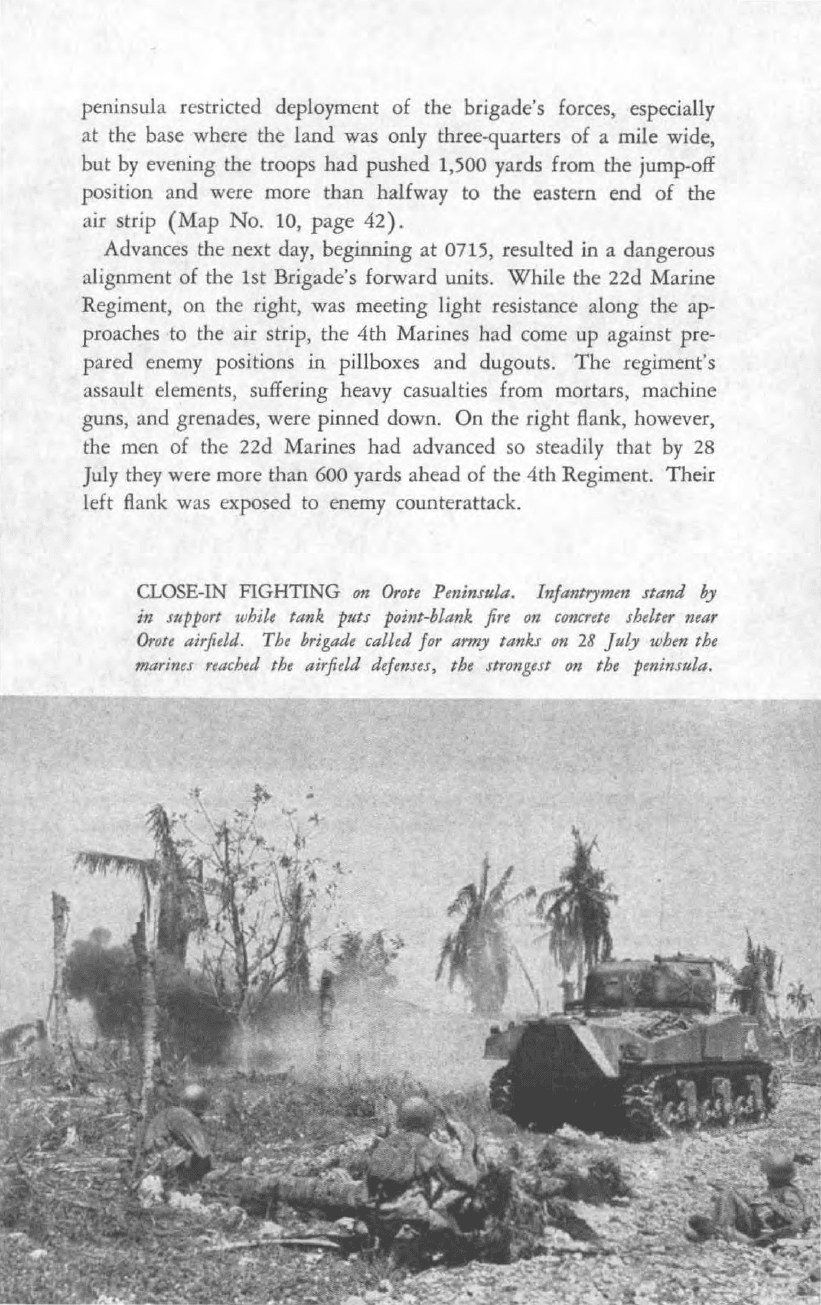
peninsula restricted deployment of the brigade's forces, especially
at
the base where the
land
was only three-quarters
of
a mile wide,
but
by
evening the troops
had
pushed
1,500 yards from the jump-off
position and were more
than
halfway to the eastern end
of
the
air strip
(Map
No_
10,
page
42).
Advances the
next
day, beginning
at
0715, resulted in a dangerous
alignment
of
the 1st Brigade's forward units.
While
the 22d Marine
Regiment, on the right, was meeting
light
resistance along the ap-
proaches to the aiI strip,
the
4th
Marines had come up against pre-
pared
enemy positions in pillboxes
and
dugouts.
The
regiment's
assau
lt
elements, suffering heavy casualties from mortars, machine
guns, and grenades, were pinned
down_
On
the
right
liank, however,
the men of the 22d Marines had advanced so steadily
that
by
28
July they were more than 600
YaIds
ahead of the
4th
Regiment.
Their
left liank was exposed to enemy counterattack.
CLOSE-IN FIGHTING
on
Oro" Peninsula. Infantrymen
"and
hy
in support tuhile lank puts point-blank
fire
on
concrete
shelter near
Oro"
airfield.
The
hrigade
called
for
army
tanks
0"
28
July
when
the
marilleJ
r
eached
the airfield defmses, the JtrotJge.st
OIl
the peninsula.
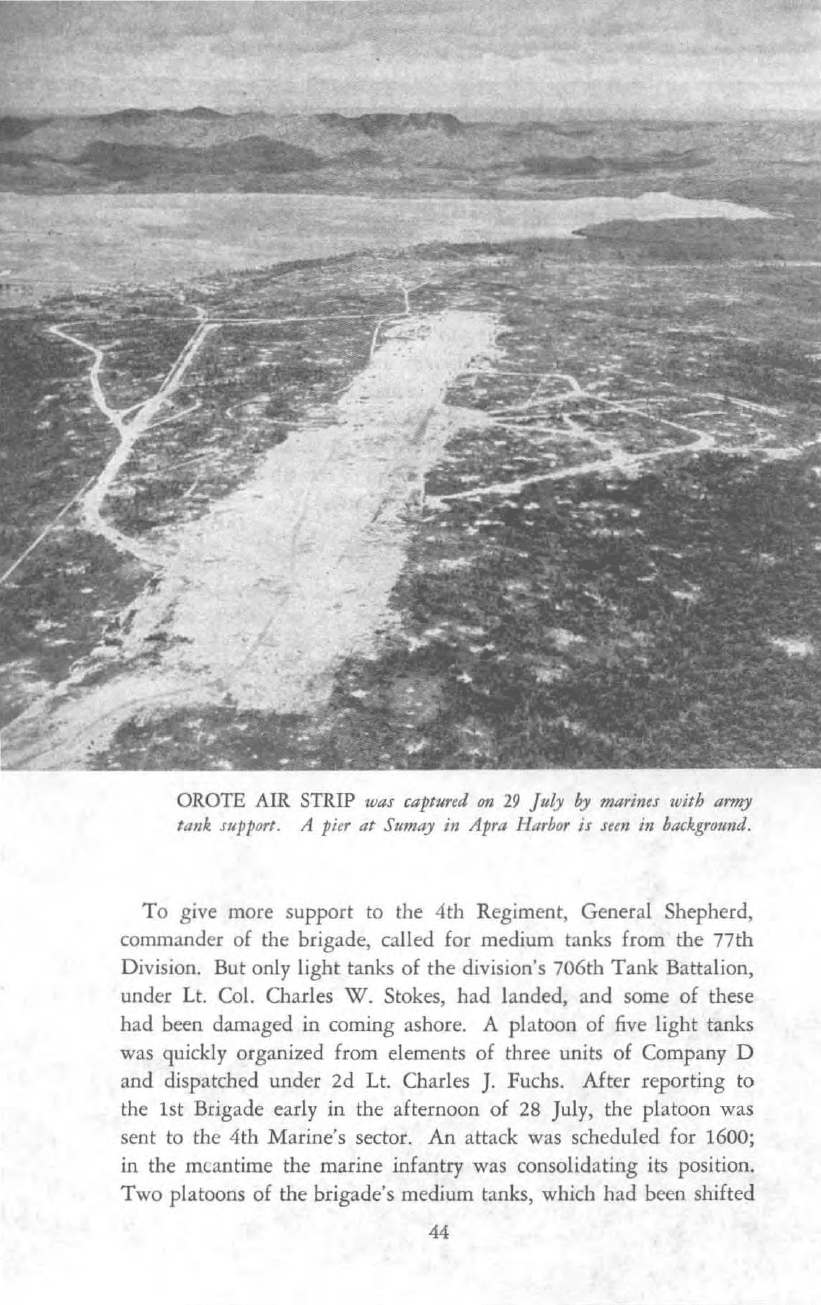
ORaTE AIR STRIP
was
captured
on
29
July
by
marines with army
tal1k support. A
pi
er
a/
Smllay ill Apra Harbor ;s
seen
ill background.
To
give more support to the 4th Regiment, General Shepherd,
commander of the brigade, called for medium tanks from the 77th
Division. But only light tanks of the division's
706th
Tank
Battalion,
under Lt. Col. Charles
W.
Stokes, had landed, and some of these
had
been damaged in coming ashore. A platoon of live light tanks
was quickly organized from elements of three units of Company D
and dispatched under 2d Lt. Charles J. Fuchs. After reporting to
the 1st Brigade early in the afternoon of
28
July, the platoon was
sent
to
the 4th Marine's sector.
An
attack was scheduled for 1600;
in the meantime the marine infantry was consolidating its position.
Two
platoons of the brigade's medium tanks, which had been shifted
44

from the 22d Regiment's sector, had reinforced the flank units.
Company
D's
platoon, joined just before the attack
by
two medium
tanks from Headquarters Company of the
706th, was to strengthen
the center of the line.
At
1600 the light tanks of Company D moved through the 4th
Regiment against the defenses that had slowed the marines.
The
tanks advanced cautiously over shell-torn terrain, and in a part
of the zone each tank covered
50
yards of the front. Fighting was
so
concentrated that most of the tank fire was directed at positions
within
10
or
15
yards of the tanks.
At
that range the 37-mm gunfire,
often sighted through crevices in log structures, was effective even
against enemy positions reinforced with tin sheeting, rocks, and
brush. Infantrymen followed the tanks closely, mopping up positions
and grenading Japanese in their fox holes. They also guarded the
tanks
so
that the enemy could not close in with grenades.
The Japanese weakened in the face of combined operations of
the infantry and tanks.
Within
two hours after the attack started
the forward elements of the 4th Regiment were abreast of the 22d
Marines on the right. In restoring the brigade's front line the tank
platoon of Company D had fired about
10
,000 rounds of .30-caliber
ammunition,
100 rounds of high explosive, and 20 rounds of canister.
The
light tanks alone destroyed 4 pillboxes, numerous dugouts, and
approximately
250 Japanese.
At
the cost of a few casualties the 1st
Brigade, supported
by
the marine and army tanks, had cleaned
out
the area on the left and now held a line stretching across the penin-
sula around the eastern end of the air strip.
At
1000 on 29 July the brigade, again supported
by
tanks, con-
tinued the attack on Orote and pushed across the air strip to the
tip of the peninsula, about two miles to the west.
The
hardest fight-
ing was for the mile-long strip, which the Japanese defended with
small arms and mortars and where they chose to die in dugouts,
pillboxes, and even a hangar rather than surrender. Less than five
hours after the attack began, the marines
had
reached the western
end of the air strip.
Without
stopping they pushed down the jungle
trails to the ocean.
At
1700, when the peninsula was completely
taken, Company D,
706th
Tank
Battalion was relieved.
In 4 days the brigade had killed between
2,000 and 3,000 Japanese
defenders on
Orate and had gained possession of the peninsnla, with
its harbor and airfield, extending 4 miles westward from the mainland.
45
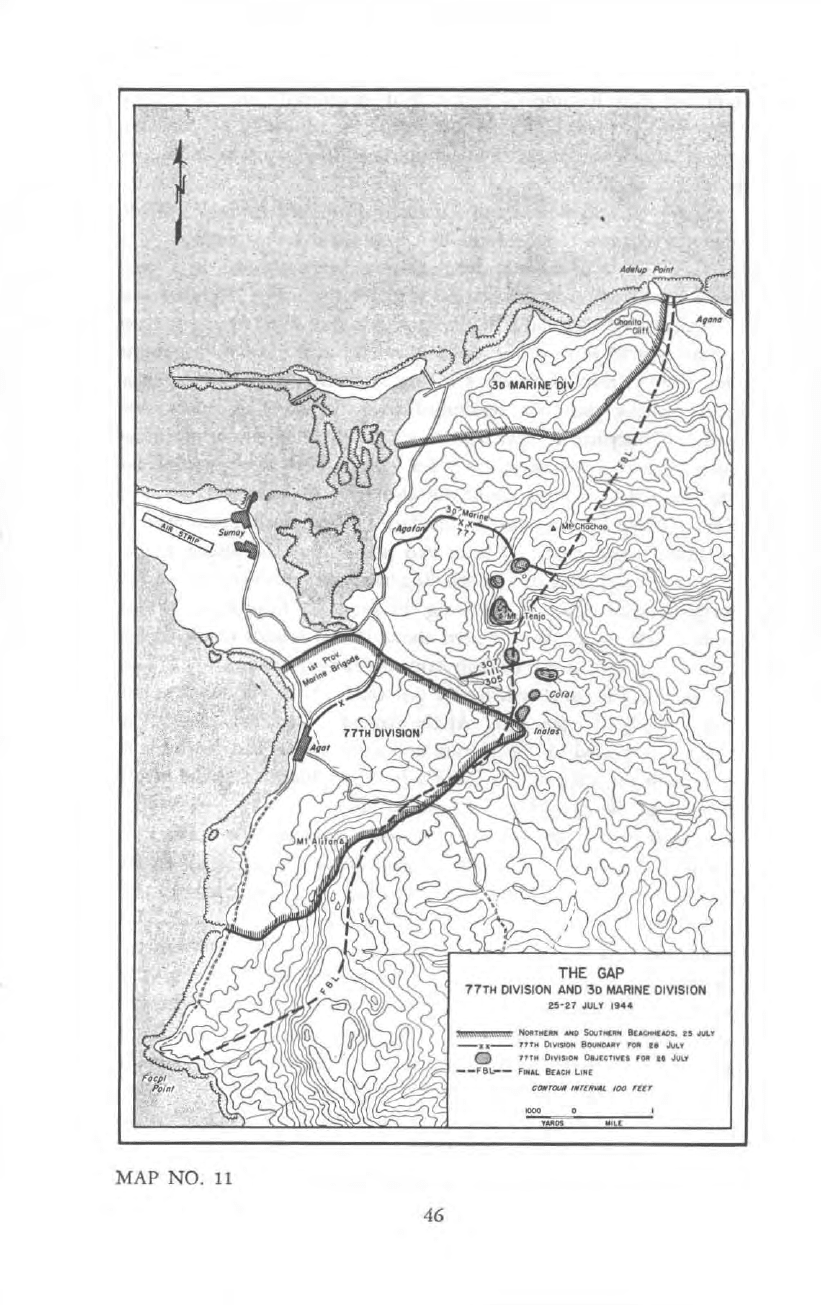
"
MAP NO,
11
46
77TH
DI
VISION
AN
O
30
MARINE
DI
VlSION
U-11
JUl."
I'
'''
~
_n,u"
_ Sau,
....
,,_on.
It
AI
...
-u-
nTM
00_
._.
_
..
M"
o
.""
0. ......
000
OIJ[Cf""l
'OIl
" JuI,.r
--
'I~
-
r_Al
8u~
1,.'10'
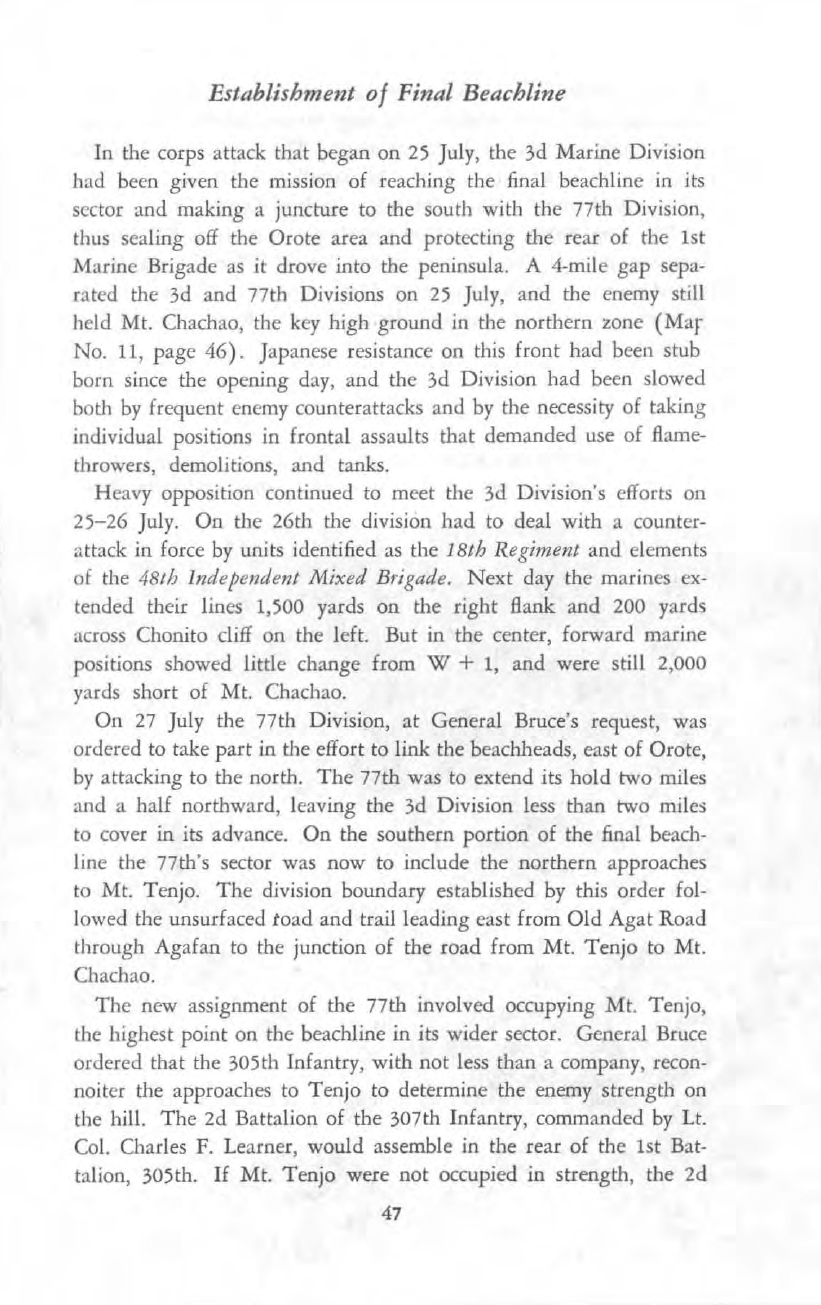
Establishment
of
Final Beachline
In the corps attack that began on
25
July, the 3d Marine Division
had been given the mission of reaching the final beach line
in
its
sector and making a juncture to the south with the 77th Division,
thus sealing
off
the Orote area and protecting the rear of the 1st
Marine Brigade
as
it drove into the peninsula. A 4-mile gap sepa-
rated the 3d and 77th Divisions on
25
July, and the enemy still
held Mt. Chachao, the
key
high ground in the northern zone
(Mar
No.
ii,
page
46).
Japanese resistance on this front had been stub
born since the opening d
ay,
and the 3d Division had been slowed
both
by
frequent enemy counterattacks and
by
the necessity of taking
individual positions in frontal assaults that demanded use of
flame-
throwers, demolitions, and tanks.
Heavy opposition continued
to
meet the 3d Division's efforts on
25-26 July.
On the 26th the division had
to
deal with a counter-
attack in force
by
units identified
as
the 18th Regimelll and elements
of the 48th Independent Mixed Brigade.
Next
day the marines
ex-
tended their lines 1,500 yards on the right flank and 200 yards
across Chonito cliff on the left. But in the center, forward marine
positions showed little change from W
+
1,
and were still 2,000
yards short of Mt. Chachao.
On
27
July the 77th Division, at General Bruce's request, was
ordered
to
take
part
in
the effort
to
link the beachheads, east of Orote,
by
attacking
to
the north.
The
77th was
to
extend its hold two miles
and a half northward, leaving the 3d Division less than two miles
to
cover in its advance.
On
the southern portion of the final beach-
line the 77th's sector was now to include the northern approaches
to
Mt. Tenjo.
The
division boundary established
by
this order fol-
lowed the unsurfaced toad and trail leading east from Old Agat Road
through Agafan
to
the junction of the road from Mt. Tenjo to Mt.
Chachao.
The new assignment of the 77th involved occupying Mt. Tenjo,
the highest point on the beachline in its wider sector. General Bruce
ordered that the
305th Infantry, with not less than a company, recon-
noiter the approaches
to
Tenjo
to
determine the enemy strength on
the hill.
The
2d Battalion of the 307th Infantry, commanded
by
Lt.
Col. Charles
F. Learner, would assemble in the rear of the 1st Bat-
talion, 305th.
If
Mt. Tenjo were not occupied in strength, the 2d
47

Battalion, 307th, moving out from Inalas
at
0700 on
28
July, was to
seize and hold the mountain, incl uding the end of the ridge south
of the peak and two knobs to the north.
The
1st Battalion, 305th,
was
to
establish contact with the
2d
Battalion, 307th, and hold the
high ground from Inalas to the ridge north of Cotal.
On order the
3d Battalion,
305th, was to send patrols north
as
far
as
the division
boundary through the area west of Mt. Tenjo.
When
General Bruce
issued his order, intelligence reported little activity on Tenjo, although
Japanese prisoners of war had declared that a force of
3,000 was
in the vicinity.
AN ANTITANK CREW
of
the J05th
ReT
defends the final beach/in<,
firing
from
its
pOJitiolJ
on
the
coastaJ
ridge
olJerlooking
HarmolZ
Road.
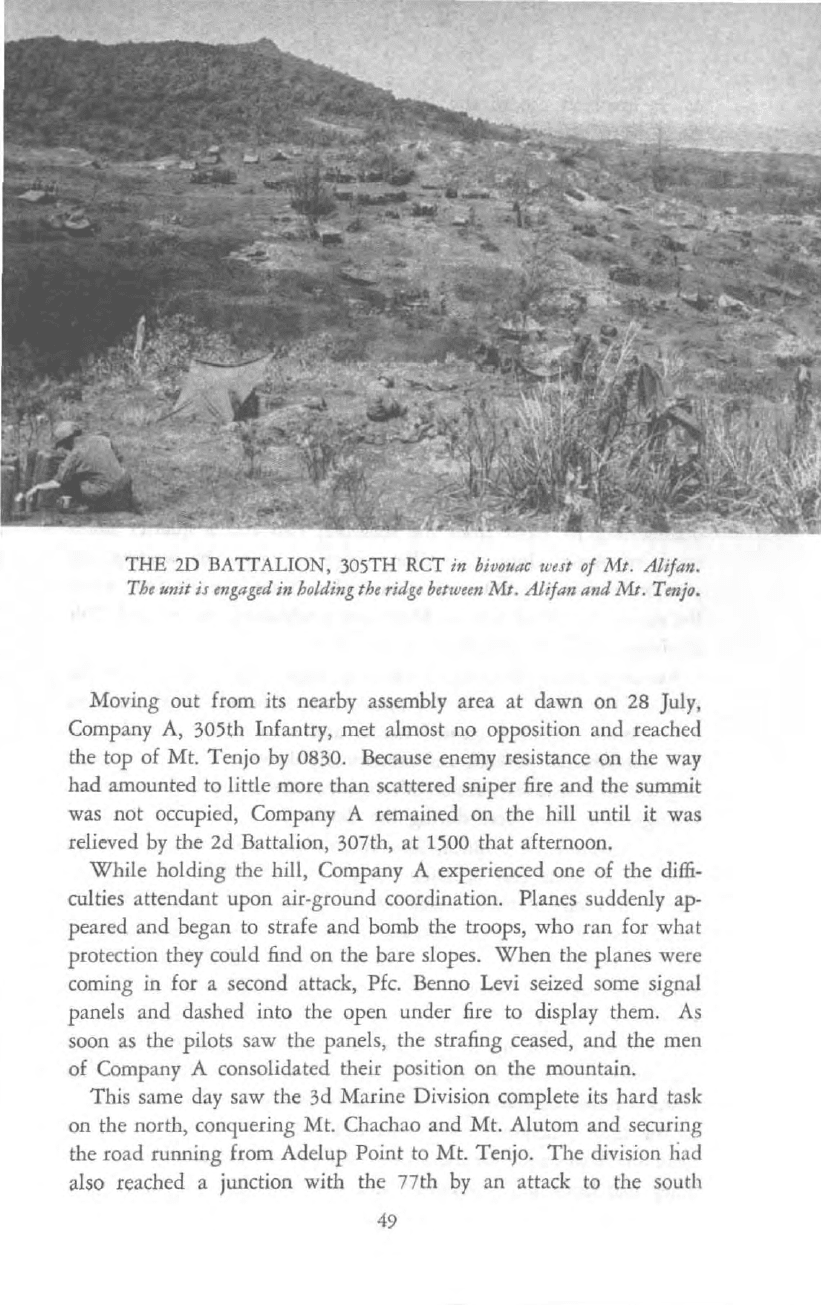
THE
2D
BATTALION, 30STH
ReT
in bivouac west
0/
MI. Ali/all.
The unit
it
engaged
in
holding the
ridge
hetween
MI.
Ali/an
and
MI.
Tenjo.
Moving out from its nearby assembly area at dawn on
28
July,
Company A,
305th Infantry, met almost no opposition and reached
the top of Mt. Tenjo
by
0830. Because enemy resistance on the way
had amounted
to
little more than scattered sniper
fire
and the summit
was not occupied, Company A remained on the hill until it was
relieved
by
the 2d Battalion, 307th, at 1500 that afternoon.
While holding the hill, Company A experienced one of the
diffi-
culties attendant upon air-ground coordination. Planes suddenly
ap-
peared and began
to
strafe and bomb the troops, who ran for what
protection they could find on the bare slopes.
When
the planes were
coming
in
for a second attack,
Pk
Benno Levi seized some signal
panels and dashed into the open under
fire
to display them.
As
soon
as
the pilots saw the panels, the strafing ceased, and the men
of Company A consolidated their position on the mountain.
This same day saw the
3d
Marine Division complete its hard task
on the north, conquering Mt. Cbachao and Mt. Alutom and securing
the road running from Adelup
Point to Mt. Tenjo. The division
I;ad
also reached a junction with the 77th
by
an attack
to
the south
49

which involved use of the 3d Battalion, 307th, under Maj. John
W. Lovell, attached
to
the marines from corps reserve.
The
3d
Battalion, 307th, and the 3d Battalion, 9th Marines, attacked abreast
with the division boundary
as
their objective. Enemy opposition was
light, and
by
1800 army and marine units were
on
the boundary
in contact with the 77th Division.
By
evening
of
28
July, while the battle for Orote was nearing its
close, the corps had pinched
off
the ground behind the peninsula.
The
capture of Mt. Tenjo
by
the 77th Division and of Mts. Chachao
and Alutom
by
the 3d Marine Division secured the entire beachline
and completely closed the gap that had existed between the divisions.
Any enemy west of the beachline was trapped.
For two days, while the 1st Brigade completed capture and
mop-
ping up of Orote Peninsula, the 3d and 77th Divisions consolidated
positions on their final beachline. Since 24 July the 77th had been
maintaining its front from the seashore, two and a quarter miles
south of Agat, along the
Allfan ridge
to
Inalas
by
sending out
platoons of scouts
2,000 yards from the beachline.
On
the 28th, when
tbe northern part of the beachline was established, the 3d and 77th
Divisions initiated patrolling in that area.
Reconnaissance platoons, threatening large-scale attacks, kept the
enemy off balance and
at
the same time gathered information on
his
movements. They burned shacks and high grass to smoke out
well-camouflaged pockets, and occasionally directed mortar and
artil-
lery
fire.
The
patrols were so effective that the enemy did not launch
a single attack in force during the daytime.
The Japanese were quick, however, to
detect this method
of
de-
fense, and
on
several occasions they tried
to
ambush tbe patrols.
On
29
July one of these ambushes put up a strong enough fight to
force a patrol of the 77th Division to call for help. While searching
out tbe ambush, one squad of scouts was pinned against the steep
side of a ravine in which the enemy was hidden. Within a few
seconds two men were killed and three otbers were wounded. A
distress flare, shot up
by
the scouts, brought reinforcements from
the 305th Regiment.
The
additional firepower
of
the regimental
platoon freed the trapped squad, and the patrol worked its way back
to
the final beach line, leaving its dead behind.
The
next day
14
dead and 1 wounded Japanese were found in the center of tbe ravine.
They had been amply supplied and well dug in.
50
